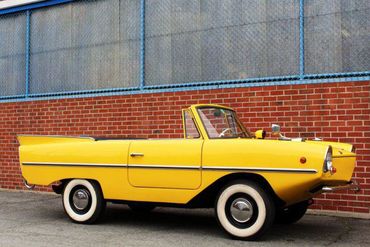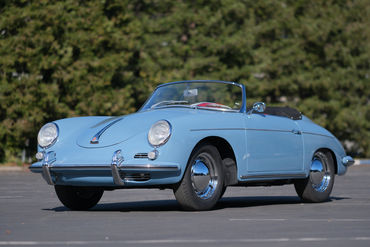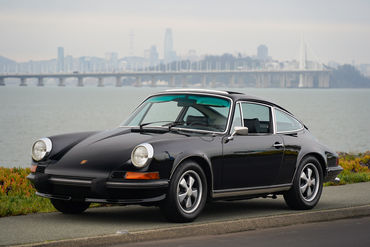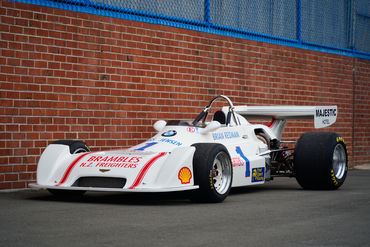Sold
SOLD 07/17
1966 Amphicar
770
It Floats, It Drives, It Skims on Fresh or Salt Water!
- VIN103834
- Exterior ColorYellow
- Interior ColorBlack
- Mileage3422 Kilometers
- EngineTriumph 1147 c.c. 4-Cylinder
- Transmission4-Speed
- StatusSold
- StockFJ2074
Description
1966 Amphicar
s/n 10 3834
Yellow with Black Interior
It floats, it drives, it skims on fresh or salt water, and with just a flick of a switch you are back on dry land cruising the streets in search of new, unchartered rivers, tributaries, deep water gulches, and lakes. And while anyone can have a Ferrari in their garage, in the event of tsunami or torrential flooding, you are prepared with the amazing 1966 Amphicar 770 ready to serve your aquatic or terrestrial needs.
Originally conceived and built in Germany by engineer Hans Trippel, the Amphicar remains the only commercially viable amphibious vehicle ever successfully sold to the general public – a huge achievement considering that most military amphibious vehicles cost ten to twenty times the price of a new Amphicar. Designed and built in Germany, and released at a time when American leisure, camping and adventure were thriving pastimes amongst post war families, the Amphicar arrived with a splash at the 1961 New York Auto Show to an astonished public. Orders were brisk, allowing the company to invest millions in development and years of engineering to refine this dual-purpose automobile. With a unique blend of 50’s charm and boating allure, the Amphicar struck a chord among recreation enthusiasts eager to engage in the combined joys of watercraft and highway use.
Among the many famous Amphicar owners, President Lyndon B. Johnson appreciated the car on many levels as told by Jospeph A. Califano, Jr. (source: National Historical Park, Texas, Presidential Vehicles)
The President, with Vicky McCammon in the seat alongside him and me in the back, was now driving around in a small blue car with the top down. We reached a steep incline at the edge of the lake and the car started rolling rapidly toward the water. The President shouted, \"The brakes don’t work! The brakes won’t hold! We’re going in! We’re going under!\" The car splashed into the water. I started to get out. Just then the car leveled and I realized we were in a Amphicar. The President laughed. As we putted along the lake then (and throughout the evening), he teased me. \"Vicky, did you see what Joe did? He didn’t give a damn about his President. He just wanted to save his own skin and get out of the car.\" Then he’d roar.
In addition to the fame and novelty these cars achieved, several people were quite adventurous with their Amphicar. In 1965, two Amphicars successfully navigated the Yukon River in Alaska, an intrepid sailor crossed from the California coast to Catalina Island in the 1970s, and in 1968, two Amphicars braved 20 foot swells and gale force winds crossing the English Channel.
The Amphicar had much to offer the eager public. Interestingly, for power, the company chose the simple yet stout British-built Triumph 1150 cc OHV 4 cylinder engine. Mounted in the rear, the engine delivered 43 bhp through the dual mode manual four-speed transmission. The front and rear coil-spring independent suspension with trailing arm front and rear were capped off with four-wheel drum brakes on a wheelbase of just 82.7”.
On land, the Amphicar drove much like any other small European car of the period. Slightly underpowered but once up to speed, quite capable. Heading into water? No need to batten down any hatches, simply lock the doors’ unique watertight seals, then drive into the water either via boat ramp or low bank shoreline. A lever redirecting the engine’s power to dual rear propellers is easily engaged activating a special Porsche-built transmission that serves both drive capacities. Using the same land controls, no longer a driver of a car, the “Captain” simply steers his watercraft using the front wheels as rudimentary rudders. Engaging reverse gear would counter rotate the twin props, serving also as a brake much as one finds on conventional boats. Upon returning to shore, the rear-engine drive and the propeller drive could be operated simultaneously until firm beaching was achieved and the propeller driveshaft could be disengaged. Astonishingly, the $3400.00 Amphicar 770 (so named for the 7mph water speed and schooner-like 70 mph land speed) sold rather well. Production lasted from 1961-1968 resulting in 3,878 units delivered to eager families all over several continents (90% of which were delivered to the US). The company ceased to do business in large part due to the US EPA and DOT regulatory changes no longer allowing the car to be imported to the US. Some years after the Amphicar Company was dry-docked, Hugh Gordon of Sante Fe Springs, California, purchased the remaining inventory of unused parts. Hugh's “Gordon Imports” still operates as the primary source for spare parts. Today, a thriving worldwide club scene exists, supplying parts, service tips, period literature, and fond family recollections of collectors both in period and from recent club regattas – a testimony to the buoyant charm and lofty spirit of the Amphicar.
This Amphicar is a 1966 model that is among the last ones built. Benefiting from the many improvements the company made over the previous 5 years of production, this car is quite sound and features a nice overall restoration which can be enjoyed and shown as is in any local or regional event. The car was purchased from a Japanese enthusiast by a prominent American collector and recently imported into the US. The paint is of good driver quality and shows well overall. The trim and various plated parts, including door handles and body trim are all in good condition with some areas being very nice to excellent particularly the bumpers and wheel trim. The convertible top raises and lowers quite easily and shows to be in very good condition with no rips or kinks in the material or inner liner, the same being true of the top boot. Lighting and lenses are in very good condition and glass appears to be quite nice with minor yellowing to the rear plastic window. Door and side glass raise and lower smoothly, revealing a striking convertible design reminiscent of American cars of the late 1950’s and early 60’s. An additional feature of this Amphicar is the rear marine pole light, an excellent option for maritime visibility.
The interior is very nicely finished and likely one of the best features of this car. The seats are well upholstered in good quality materials, rubber floor matting is also in good shape, and the dashboard is very nicely finished with very nice, period correct instruments and AM/FM radio that should look very familiar to collectors of Porsches and Volkswagens from this period. Finishing off the interior are newer rubber trims and various window gaskets that are in good condition. The engine room is well equipped with the Triumph engine having been nicely finished with correct period details and some upgrades to improve reliability. The car starts and runs smoothly but has not been tested recently for water use so we cannot verify the hull integrity beyond it’s use as a motor vehicle at this time and recommend a detailed water test before taking the plunge.
Driving the Amphicar on the street achieves a high water mark, attracting significant attention from onlookers both port and starboard. Collectors should be prepared to engage in conversations at filling stations and tackleshops, as the Amphicar seems to propel great curiosity and enthusiasm from mainlanders. Those who know the dual capability can be heard yelling “Ahoy”, with an encouraging thumbs-up or “hang loose” gesture.
This example has been mechanically sorted after a period of storage, with recent attention given to the braking system. The carburetor and starter have been rebuilt, and a new battery installed. The tires, while correct in size and type are rather dated and should be replaced should the new owner wish to drive it regularly. The undercarriage appears very sound in construction and shows no evidence of significant damage to the chassis. All suspension and drive mechanisms appear to function as expected. It should be noted that while the car has not been used in the water, the transmission does engage the twin propellers as intended when activated via lever release in the cabin, with both propellers moving freely through the two-speed marine mode, in forward and reverse.
Amphicars have become darlings of the collector hobby in recent years, achieving prices in excess of six figures at auction houses throughout the world. And while you’d have to sail far and wide to find a car that meets the needs of both water and land transportation with as much charm and delight as the Amphicar 770, a very capable one awaits your mooring, ready to go. Unique and capable in many respects, the Amphicar signifies our spirit of adventure, not just on the highways across land, but across rivers, lakes and streams. Whether you are leisurely fishing for lake trout, bobbing along a slow moving creek, or ambling shoreward later in the day to set up camp and fry up your daily catch, the Amphicar does it all with eager buoyancy and all hands on deck. Anchor and Dramamine not included.
Please note that ownership documentation refers to this car as a 1963, and that the title is in proces.
The above vehicle information is complete and accurate to the best of our knowledge at the time it is posted to this website. Corrections or additional information is always appreciated. All advertised prices exclude government fees and taxes, any finance charges, any dealer document preparation charge, and any emission testing charge. Vehicles are subject to prior sale. All advertised to be true but not guaranteed. We assume no liability for errors or omissions.
Inquire About This Car
Fantasy Junction • 510-653-7555 • 1145 Park Ave, Emeryville, CA 94608





